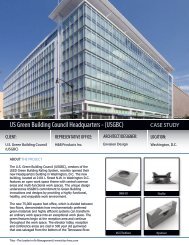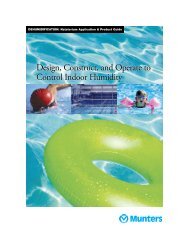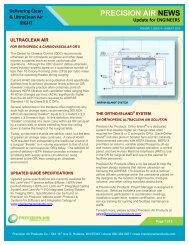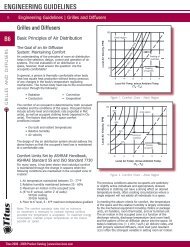Titus 2008 - 2009 Product Catalog | www.titus ... - Texas Air Products
Titus 2008 - 2009 Product Catalog | www.titus ... - Texas Air Products
Titus 2008 - 2009 Product Catalog | www.titus ... - Texas Air Products
Create successful ePaper yourself
Turn your PDF publications into a flip-book with our unique Google optimized e-Paper software.
ENGINEERING GUIDELINES<br />
B<br />
B58<br />
TERMINAL CONTROLS AND ACCESSORIES<br />
Engineering Guidelines | Terminals, Controls and Accessories<br />
Typical Problems (continued)<br />
Non-Compliance with Local Codes<br />
Some localities have stringent codes of their own, with<br />
requirements beyond those of NEC, UL, and CSA. An<br />
example is the primary fusing in the control transformer at<br />
the right (Figure 99).<br />
Installation Techniques-Duct Connections<br />
The inlet duct slips over the inlet collar of the terminal.<br />
It should be fastened and sealed according to the job<br />
specifications.<br />
The diameter of the inlet duct must be equal to the listed<br />
size of the terminal. For example, a duct that measures 8” in<br />
diameter must be fitted to a size 8 terminal. The inlet collar<br />
of the terminal is made ⅛” smaller than nominal size in<br />
order to fit inside the duct (Figure 100).<br />
Note: A duct should never be inserted inside the inlet collar<br />
of the terminal.<br />
For optimum control accuracy, a straight section<br />
of unrestricted duct at least 1½ diameters long should be<br />
installed at the inlet (Figure 101). Where this condition<br />
does not exist, field adjustment of the airflow setting on the<br />
velocity controller may be required.<br />
If space does not permit using the 1½ diameter length of<br />
straight duct, a hard duct elbow up to 90° can be installed<br />
at the inlet of the <strong>Titus</strong> terminal without altering the factory<br />
maximum or minimum airflow setting by more than 10%<br />
(Figure 102).<br />
The outlet end of the <strong>Titus</strong> terminal is designed for a<br />
slip and drive connection. Unless a round duct adapter<br />
is furnished, a rectangular outlet duct should be fitted to<br />
match the size of the terminal casing. It should be fastened<br />
and sealed according to the job specifications.<br />
If a round outlet adapter is furnished, it should be fastened<br />
and sealed by the same method used for the inlet.<br />
Close coupling the terminal inlet to the side of the main<br />
supply duct is not recommended. Where this condition is<br />
unavoidable, a flow straightening device (Figure 103)<br />
should be installed between the main supply duct and<br />
the inlet to the terminal. Even with the flow straightening<br />
device, the terminal may still require some field adjustment<br />
of the factory airflow settings at the velocity controller.<br />
<strong>Air</strong> leakage adds significantly to the operating cost of an<br />
HVAC system. Important savings are realized by carefully<br />
fitting and sealing all duct joints and specifying tightly<br />
constructed <strong>Titus</strong> terminals. The <strong>Titus</strong> box has very low<br />
damper and casing loss leakage. These values can be found<br />
on page Q26.<br />
<strong>Titus</strong> <strong>2008</strong> - <strong>2009</strong> <strong>Product</strong> <strong>Catalog</strong> | <strong>www</strong>.<strong>titus</strong>-hvac.com<br />
277 VAC<br />
277 VAC<br />
Figure 99. Primary Fusing in the Control Transformer<br />
Straight Duct<br />
Figure 100. Terminal Inlet Collar Fitting Properly<br />
Flexible Duct<br />
Fuse<br />
Inlet<br />
Inlet<br />
Transformer<br />
Terminal<br />
24 VAC<br />
24 VAC<br />
Figure 101. Unrestricted Duct Properly Install at the Inlet<br />
Hard<br />
Duct<br />
Elbow<br />
1.5 Diameter<br />
Minimum<br />
Inlet<br />
Terminal<br />
Terminal<br />
Figure 102. 90 Degree Hard Elbow Duct Installed to Inlet<br />
Main Supply<br />
Duct<br />
Inlet<br />
Terminal<br />
<strong>Air</strong><br />
Straightener<br />
Figure 103. Flow Straightening Device Placement








